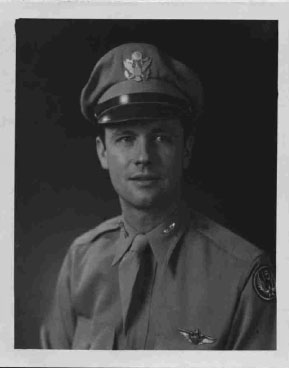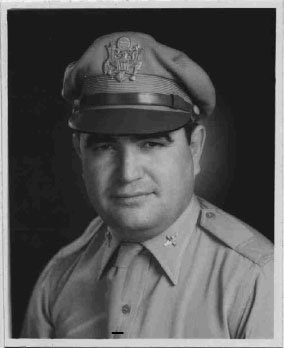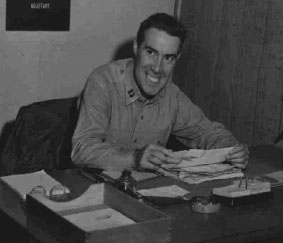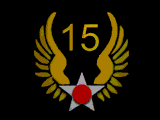|
450TH BOMB GROUP (VH) SECOND AIR FORCE HISTORY
REDEPLOYMENT/TRAINING: 1 AUGUST TO 31 AUGUST 1945

ORGANIZATION AND ADMINISTRATION
The administrative framework has now been set up so that
Group Headquarters assumes no squadron responsibilities. Those responsibilities
which it was found permissible to delegate to the squadrons have been relegated
thereto. In this respect, administration is similar to that of a base unit,
with Group personnel acting purely in a supervisory capacity.
Squadrons are at present functional charts. The third of
September has been set as completion date.
Volume of administrative activity since date of activation
has been extremely large. Much of the volume has been due to voluminous
correspondence in connection with the 450th Bomb Group (H), of which
the 450th Bomb Group (VH) is a continuation following initial
redeployment. Additional administrative activity has been caused by the
acquisition and subsequent transfer of personnel having too high an Adjusted
Service Rating.
On 13 August, the 17th Bombardment Operational
Training Wing relinquished control of assignment and transfer of personnel to
this unit. Since that date, the unit has dealt directly with Second Air
Force.
PERSONNEL
At the start of the month, the Group had 90 officers, 1
warrant officer and 1109 enlisted men at the end of the month, the Group have
105 officers, 1 warrant officer and 999 enlisted men. Authorized strength of
the Group is 461 officers, 1 warrant officer and 1618 enlisted men.
Pursuant to direction from Second Air Force 82 enlisted men
were transferred to Harvard Army Air Field. Eight enlisted men, who signed
required waivers, remained with Group.
At the close of the period the Group had a marked shortage
of munitions handlers (MOS 901), light truck drivers (MOS 345), and airplane
maintenance technicians (MOS 750). These were the same shortages that were
noted during the period covered by the last writing.
The month opened with nearly all personnel filled with an
eager expectation of soon being sent overseas. Despite the fact that Harvard
Army Air Field was overcrowded, and in general compared unfavorably in many
respects with the majority of other air fields (poor transportation to nearby
towns heading the list) the greater majority of personnel were resigned to the
aforementioned conditions in the realization that stay on the field would be of
limited direction. Conditions were soon to present themselves that would
quickly dispel such resignation.
On Friday, 10 August 1945, the first official indication
that the Japanese would capitulate broke forth upon the world…and to the
personnel of the 450th Bomb Group, it brought with it a feeling of
fear…fear, anxiously felt, of an unlimited tour of duty as part of an
occupational force. Many men in the Group have been in the service at least as
long as most of the men now overseas. The majority of such men were often
frozen in job or MPOS. Many who had requested combat assignments were told that
their time would come, but that now they were necessary in their present
station at their present duty. Now it would seem that these very same key,
former base-unit personnel whom the 450th was so happy to obtain,
would find themselves heavily penalized as a result of a matter over which they
had absolutely no control. The men themselves felt this, and it resulted in a
feeling of indifference, unrest, and dissatisfaction that grows steadily worse
with the passage of time. Consensus of opinion on the matter of discharges
based largely on overseas service is that such a basis is decidedly unfair.
Many single men have adopted a feeling of resignation to the worst; the married
men, with but few exceptions are exceedingly bitter, and strongly opposed to an
extended tour of foreign occupational duty.
SUPPLY AND EQUIPMENT
One of the major problems that presented itself during this
period was to be found in the matter of packing for overseas. In that respect,
a delay was encountered due to the failure to receive promptly 960 boxes
ordered from Air Technical Command at Oklahoma City. Theses boxes were to have
been shipped by Army truck on 18 August 1945. Inquiry revealed that the boxes
in question were not hipped until 21 August and were sent by railroad fright
rather than by the requested method. To date, these necessary packing boxes
have not arrived.
In an attempt to overcome the shortage of packing boxes,
shipping crates and waterproof bags were constructed by supply personnel. All
such available equipment was utilized during the course of the month.
Forty boxes of morale equipment were packed and shipped on
21 August. These boxes contained electrical supplies, athletic equipment, and
similar miscellaneous material. Sixty percent of Air Corps TAT equipment, fifty
percent of Quartermaster equipment and 12 crates of Signal TAT equipment were
received during the month.
Old TAT equipment brought back by the 450th Bomb
Group (H) from the European Theatre of Operations continues to be received at
this station. All old TAT weapons which had been received were turned in 29
August 1945. Sufficient Ordnance equipment to supply two squadrons was received
during the period. This equipment included carbines, bayonet knives, and
machine guns.
No defective equipment was notice on inspection during
packing. Supply procedure remained unchanged during the month.
Inadequacy of storeroom space was partially solved by the
erection of seven large tents under which supplies were placed. On 30 August,
the supply section took over building #626. A former mailroom…but nonetheless,
storage facilities as of the end of August continue to be inadequate.
During the clothing processing, the supply section was
unable to completely outfit any one man, there being a critical shortage of
ponchos, duffel bags, raincoats, and other items. Kansas City Depot was advised
of such shortages.
As of 31 August, there remains a great many shortages of
critical items. Equipment, however, continues to pour in and the situation is
clearing rapidly. Forms 413 are being kept posted to date showing running
account of shortage and receipts of T/O & E.
SPECIAL PROJECTS
A special Medical and Administrative processing project was
started 16 August and completed 23 August. This processing was ordered by the
Group Commander in view of the probability of early overseas movement.
Ninety-nine percent of enlisted men were administratively
processed over the eight day period. A processing line was set up in building
1100, with the following steps.
1. Group
medical officers administered needed immunization inoculations.
2. Needed
dog tags were made by base personnel.
3. Forms 41
(designation of beneficiary), 43 (emergency addressee), 971 (V-Mail change of
address), and 28 (Soldier's Pay Data Book) were checked by Group personnel.
4. Form 24
was thoroughly checked by Group personnel as to name, rank, serial number, tome
lost, furloughs, court partials, Foreign Service, awards and decorations. Class
E, F and B allotments, insurance and remarks pertaining to pay status.
5. Form 20
(Adjusted Service Rating) also was checked by Group personnel.
6. Form
28-A (Physical Training) was filled out by Group personnel and inserted in 201
file.
7. Forms 28
(Soldier's Pay Data Book), 41 (Designation of Beneficiary), 43 (Emergency
Addressee) and 971 (V-Mail change of address) was checked by base personnel.
8. Personal
Affairs statement was checked by base civilian personnel.
9. Base
personnel saw that persons being processed signed statement that all records
check were in 201 file.
10. In
final processing check, each form filled out was checked off against check
sheet. The processee then surrendered his 201 file to Group personnel.
All ground officers were processed on 23 August. Particular
emphasis was placed on checking MOS, Officers Efficiency Rating From, and
Adjusted Service Rating Form.
Rated personnel were processed by base personnel in building
301 on 31 August. Full field equipment was drawn by all Group officers from
base quartermaster on 31 August.
Clothing processing started 20 August and continued for
balance of month as clothing became available.
Certain difficulties were encountered in administrative and
medical processing. There was a shortage of standard War Department AGO forms
such as Allotment Forms and Soldier's Pay Data Books., Group Medical Officers
exhausted the field's supply of smallpox vaccine. Sufficient vaccine to
complete processing was obtained from Hastings Naval Ordnance Depot. Needed
forms were flown by air from nearby air fields.
On 10 August, POM inspectors visited the organization.
On 20 August, IG inspectors made an inspection.
MAINTENANCE
Maintenance has been set up according to Second Air Force
Regulations 65-16, which requires men to be assigned in three sections and
maintenance control, according to their MOS.
Three B-29's have been assigned by Harvard Army Air Field to
the 450th Bomb Group for men to carry on flight line maintenance.
All required maintenance and inspections of these planes are being performed by
en of the 450th.
In addition to working upon the three assigned planes, men
are receiving on-the-job training by working in hangars and on flight line with
base personnel.
Men have been assigned to corresponding base sections and
work under supervision of base officers who are responsible for training of
such personnel.
Section B has assumed charge of one inspection hangar; base
personnel operate the second inspection hangar.
Enlisted men who had no B-29 training were sent to a base
technical school for training specified by Second Air Force.
COL. ELLSWORTH R. JACOBY

Commanding Officer of the 450th Bomb Group (VH)
is Col. Ellsworth R. Jacoby who led the Group while it was in ETO from 17
November 1944 and guided it through the redeployment phase.
Col. Jacoby was commissioned a 2nd Lt. in the
Infantry upon being graduated from US Military Academy 12 June 1939. He
transferred to the Air Corps 22 June 1940. Before the outbreak of war, he
served as instructor and flight commander at Randolph Field. From 1 November
1941 to 15 March 1943, Col. Jacoby saw duty at Army Flying School at Enid,
Oklahoma as Commandant of Cadets, Operations Officer, Squadron Commander and
Director of Flying. From 17 May 1943 to 12 November 1943, he was stationed at
Will Rogers Field and served as instructor, Executive Officer and Air Inspector
in Bomb Groups. Laving Oklahoma City, he served at Muskogee, Oklahoma and
Columbia, South Carolina before going overseas in May 1944.
On 14 June 1944, Col. Jacoby joined the 450th
Group becoming Commanding Officer of 723rd Squadron. He continued in
those duties until 25 September 1944, when he became Deputy Group Commander. On
17 November 1944, he became Group Commander.
Starting out as a 2nd Lt. 12 June 1939, the
Colonel was promoted to 1st Lt., 9 September 1940, to Cpt., 1
February 1942, to Major, 17 July 1942, to Lt. Col., 26 July 1944, and reached
his present rank 23 February 1945 while heading the 450th in combat.
While serving overseas he was awarded the Silver Star and Distinguished Flying
Cross.
Col. Jacoby was born 19 October 1914 in Missouri. He
attended Wentworth Military Academy 1931-33, University of Missouri 1933-35,
obtaining his BS degree I Chemical Engineering, and US Military Academy
1935-39.
LT. COL. WILLIAM A. MCWHORTER

Deputy Commanding Officer of the 450th Bomb Group
(VH) is Lt. Col. William A. McWhorter who held the position while the Group was
in ETO. Before becoming Deputy Commander 21 November 1944, Col. McWhorter had
served as Commanding Officer and Operations Officer of the 722nd
Bomb Squadron (H). Prior to going
overseas in early 1944, he had seen duty as pilot instructor and Director of
Flying a t Kelly and Maxwell Fields, and later had served as Operations Officer
of 609th and 610th Squadrons at Alamogordo and
Charleston.
Col. McWhorter was born 11 June 1916 I Dewey, Oklahoma. From
1933 to 1938 he attended Oklahoma A & M and Oklahoma State Teachers
College, majoring in engineering and mathematics. Upon completion of flying
training, he was commissioned at 2nd Lt. 30 August 1940, was
promoted 1st Lt. 1 February 1942, Capt. 8 July 1942, Major 2 July
1943, an reached his present rank 23
August 1944. While serving overseas he was awarded the Silver Star, DFC
wit Cluster, Air Medal and Purple Heart.
MAJOR JOHN H. WELLS

Executive Officer of the 450th Bomb Group (VH) is
Major John H. Wells, JR. who, from 1 November 1944 served the unit overseas as
Group Adjutant. Major Wells is one of the oldest members of the Group in points
of service with it, joining the 720th Bomb Squadron in Alamogordo as
Adjutant 1 June 1943. He became Executive Officer of the Squadron on 30 August
1944.
Major Wells entered the army 4 June 1941 and was
commissioned 16 April 1943 upon completion of OCS. He was promoted to 1st
Lt. 9 December 1943, to Captain 7 July 1944, and reached his present rank 17
March 1945. While serving in the ETO, Major Wells was awarded the Bronze Star.
Before entering the army, Major Wells attended the
University of Washington and later became manager of the California Curtain
Manufacturing Company in Los Angeles. He was born 16 February 1915 in Cape
Girardeau, Missouri.
CAPT. CARTER W. RIEFNER

Adjutant of the 450th Bomb Group (VH) is Capt.
Carter W. Riefner who joined the Group upon its redeployment at Harvard Army
Air Field. Capt. Riefner assumed his present position after serving three
months in the Personnel Processing Section of Second Air Force Headquarters,
and serving as Personnel Assignment Officer in Second Air Force Headquarters
four months.
Prior to threat assignment, he had seen service as assistant
adjutant and adjutant on Harding Field.
Capt. Riefner was born 15 September 1915 in Baltimore, MD.
He attended Baltimore City College and Western Maryland College, majoring in
Mathematics and History, and obtaining AB and AM degrees. Taking ROTC in
college, he was commissioned upon being graduated. He was called to active duty
as 2nd Lt. on 7 October 1942. On 3 February 1943, he was promoted to
1st Lt. and on 7 October 1943, to Captain. For three years before
entering the army, Captain Reifner was a teacher in Baltimore Schools.









NOTE: 450TH BOMBARDMENT GROUP (VH) WAS
DEACTIVATED ON OCTOBER 15, 1945
|



